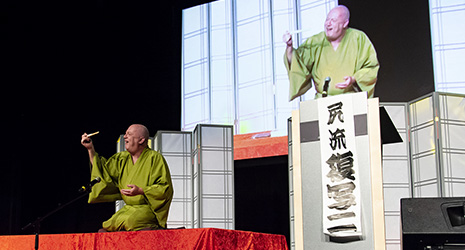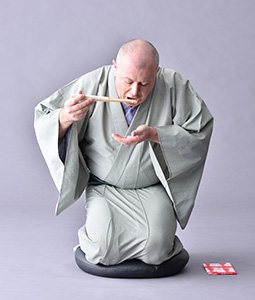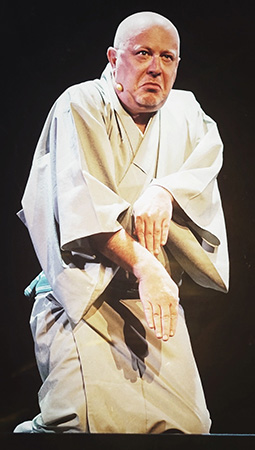December 2022
Conveying the Charm of Rakugo to the French-Speaking World

Coppini performing in French-speaking Montreal, Canada

Cyril Coppini performs a rakugo story using his fan as “chopsticks” 
Coppini strikes a pose

Cyril Coppini from France is sharing the charm of rakugo with audiences and readers in Japan and the French-speaking world, both through his story-telling performances and his translations of rakugo-related works.

Rakugo is a traditional storytelling art established in Japan in the mid-17th century. It is widely performed even today, ranging from classic rakugo that has been handed down for generations to creative rakugo by modern rakugo performers, but all the tales told are humorous stories about the common people and human feelings. Another feature of rakugo is that the performer, wearing a kimono, remains seated on a cushion as they play several roles by themselves, differentiating between the characters only through the tone of their voice and gestures, without relying on costumes or stage art.
Cyril Coppini from France is a rakugo performer, working mainly in Japan and France. He explains, “Rakugo is said to ‘express a big world with small movements,’ and the only props are a fan and a hand towel, which are used in place of various objects to appeal to the imagination of the audience. That it relies on this promise between the performer and the audience is what is most attractive about rakugo, you know.”
In the high school that Coppini attended in Nice, southern France, Japanese was offered as an elective. Coppini was drawn in by how much fun it was when he tried it, and he went on to major in Japanese at university before acquiring a master’s degree in linguistics and Japanese modern literature from the National Institute of Oriental Languages and Civilizations (INALCO). “Rakugo” often appeared in the essays of the novelists that he researched at this time. “But the Internet wasn’t widespread back then, so I was always curious about what actual rakugo is like,” Coppini says.
In 1997, Coppini got a job at the Institut Français, a cultural center attached to the French Embassy in Tokyo. In Tokyo, he went to yose, theaters showcasing popular performing arts that he had longed to visit, and saw rakugo for the first time, which he says impressed him deeply. Later, while engaged in cultural exchange work between France and Japan, he met Hayashiya Someta, a practitioner of Kamigata rakugo (rakugo developed in Kyoto and Osaka, as opposed to the “Edo rakugo” of Tokyo), and started learning the basics of rakugo in 2010. In 2011, he won a prize at the International Convention of Amateur Rakugo in Chiba, performing under the rakugo stage name “尻流複写二” (Cyril Coppini). Every year from 2016, Coppini toured in France to perform rakugo that he himself has translated into French, taking care so as not to spoil its charm.

Coppini’s specialties include Chiritotechin, which is a humorous story about a man who boasts about having eaten a fictional food, and Tanusai, which is a cute dialogue between a man and a child racoon who tries to return a favor to the man for saving the young racoon in the forest. Coppini explains, “When performing in France, I often do Shinigami (The Grim Reaper) as well. It’s a story about the Grim Reaper helping a man who is stuck in debt. Shinigami is a story usually performed by a rakugo master at the grand finale of a show. However, this story is actually based on a Grimms’ fairy tale and is familiar to Westerners too. Coupled with a dimming of the lights to match the story, I can draw in the French audience.”
Coppini also translates Japanese comics into French. One of his favorite stories, among the ones he has translated himself, is Descending Stories: Showa Genroku Rakugo Shinju by Kumota Haruko. The story is set in the world of Japanese rakugo from the 1930s to the 1970s, and develops from a scene in which the protagonist is moved by hearing the Shinigami rakugo.
Coppini says, “There are several other interesting manga based on rakugo, so it might be a good idea to get to know it through that first. Rakugo is a culture of gentle laughter that doesn’t hurt people. I think it has the power to save the world.”
Someday, Coppini hopes to hold an intensive course in France to teach rakugo and convey its depth.

